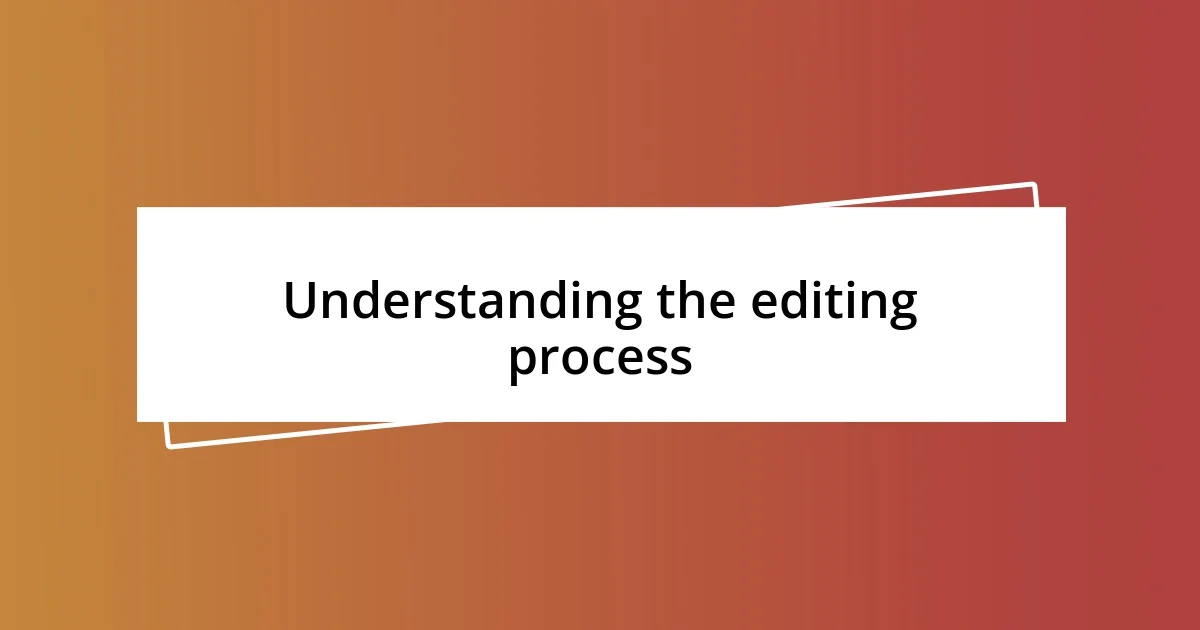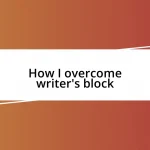Key takeaways:
- Utilizing a multi-step approach in editing, focusing first on structure and themes before fine-tuning grammar and style enhances the overall clarity and flow of writing.
- Taking breaks from your draft allows for fresh perspectives, making it easier to identify flaws and areas for improvement during the editing process.
- Seeking specific feedback from peers can uncover overlooked issues and lead to significant improvements in your writing’s quality and engagement.

Understanding the editing process
Understanding the editing process is essential for refining our drafts into polished pieces. I often find myself immersed in my own work, only to realize after a few days away that I’m blind to certain flaws. Have you ever felt that way? This distance helps me approach my writing with fresh eyes, making it easier to spot inconsistencies and awkward phrasing.
When I sit down to edit, I try to embrace a multi-step approach. First, I focus on overarching themes and structure; this sets the foundation for a compelling narrative. I remember one instance where rearranging a few paragraphs completely transformed the flow of my piece, creating a more engaging experience for readers. It’s a powerful reminder of how the order of words can evoke different emotions and reactions.
Next, I dive into the nitty-gritty details, like grammar, punctuation, and word choice. This stage usually feels pretty tedious, but I’ve learned that every small adjustment counts in delivering clarity. Isn’t it fascinating how a single misplaced comma can change the meaning of a sentence? These minor edits often make the final draft not just readable but truly enjoyable.

Preparing your draft for editing
Before diving into the editing phase, I’ve discovered that having a well-prepared draft can make all the difference. It’s not just about fixing mistakes; it’s about approaching the draft as if it’s a blank canvas, waiting to be refined. To facilitate this, I recommend taking a brief break from your work after completing a draft. I once stepped away for a weekend, and when I returned, I was astonished at how easily the flaws jumped out at me. It’s liberating!
Here are some steps I find useful in preparing my draft for editing:
– Set Aside Your Work: Take a break before revisiting your draft.
– Print It Out: Reading on paper can help you catch errors you might miss on the screen.
– Read Aloud: Hearing your writing can reveal awkward phrases or rhythm issues.
– Shift Your Focus: Look for different aspects in each round of edits, such as structure in one pass and grammar in another.
– Create a Checklist: Jot down common issues you tend to overlook, so you can systematically address them.
By following these steps, I’ve often found that the path to a polished piece becomes not only clearer but also a lot more enjoyable. It’s like unearthing hidden gems within a rough diamond!

Initial read-through for clarity
When I do my initial read-through, I focus on clarity before anything else. I’ve learned to let the words wash over me, trying to experience my writing as a reader would. Once, while reviewing an article, I found a section where I was too verbose. Cutting those extra words made the message so much clearer—it felt like cleaning a fogged-up mirror. Have you encountered moments like that in your writing?
During this stage, I also pay attention to the flow between paragraphs. I often ask myself, “Does this logically lead to the next thought?” It’s surprising how a disconnect can throw off the reader’s understanding. For example, in one draft, I realized a transition I thought was smooth felt abrupt. Making a simple adjustment to bridge those ideas made the entire piece sing in unison.
In this initial phase, I sometimes jot down quick notes in the margins, capturing my immediate impressions. These notes are invaluable; they serve as a roadmap for deeper edits later on. I once missed catching a critical inconsistency because I didn’t trust my initial feelings during a read—now, I prioritize those gut reactions.
| Aspect | Initial Read-Through |
|---|---|
| Focus | Clarity and coherence |
| Method | Read without distractions |
| Outcome | Identified overarching issues |

Making structural adjustments
Making structural adjustments is where I find the real transformation of my draft takes shape. I look at the overall structure like a blueprint—does it have the right foundation? A few months ago, I was editing an essay and realized a key argument was buried in the middle when it needed to be upfront. Rearranging paragraphs not only clarified my message but ignited a fresh energy in the writing. Have you ever felt that rush of alignment when everything just clicks?
Sometimes, I visualize my piece as a story arc. Each section builds upon the last, so I often ask myself, “Is there a natural progression?” I recall a time when I had two related ideas presented on separate pages. By weaving them together into one cohesive section, the narrative flowed seamlessly, almost like a dance. It’s fascinating how a little restructuring can turn a jumble of thoughts into an engaging and persuasive narrative.
In terms of specific adjustments, I might even pull entire sections out if they don’t serve the bigger picture. Just last week, I had a paragraph full of great points, but it felt like it was in the wrong story. Cutting it felt tough initially, but I knew it freed up my main argument to shine through without distractions. For me, these little sacrifices are essential in sharpening the focus and ensuring every line serves a purpose. Isn’t that what we all strive for in our writing?

Refining language and style
When it comes to refining language and style, I always pay close attention to word choice and sentence structure. The right word can change the entire tone of a piece. I remember editing a piece where I used “utilize” instead of “use.” The latter felt simpler and more approachable, which is exactly what I wanted for that audience. Have you ever noticed how a slight tweak in vocabulary can make your writing feel more inviting?
I also find that varying sentence lengths helps maintain the reader’s interest. Some sentences can be short and punchy, driving a point home powerfully, while others can be longer, incorporating more detail and nuance. This rhythmic variation allows me to emphasize important ideas and keep the reader engaged. For instance, while revisiting an old draft, I found a convoluted sentence that could be broken into two simpler ones. Not only did it make the point clearer, but it also created a sense of ease. How do you think your audience responds to different rhythms in your writing?
Additionally, I often read my drafts aloud to catch awkward phrasing or repetition. Hearing my words lets me experience the flow differently. A few weeks ago, while reading aloud, I stumbled over a clunky phrase that sounded fine in my head but was a mouthful. It was a gentle reminder that the auditory element is as crucial as the visual. It helps me ensure my writing sounds natural and true to my voice. Have you tried this approach? It can be a game-changer in achieving the right tone and style!

Final proofreading techniques
Final proofreading is where I put my previous insights into practice. I often take a step back and look for any lingering typos or grammatical errors that might slip through the cracks during earlier edits. Last month, while proofreading a newsletter, I spotted a misused “there” instead of “their.” It was easy to miss in the flow of reading, but catching it changed the professionalism of the entire piece. Have you ever felt that relief when you spot a mistake right before you hit send?
I also focus on consistency in formatting and style. I remember one time, I had a report where headings were a mix of bold and italics. It seemed minor, but when I corrected them all to the same style, the document looked so much more polished. Paying attention to these details ensures the final product not only reads well but also looks cohesive. Isn’t it satisfying to see everything aligned?
Another technique I use is the “fresh eyes” approach. After I’ve polished my draft, I leave it for a few hours—or even a day—before revisiting it. This distance provides a new perspective, allowing me to spot issues I was too close to see before. Recently, I applied this to an article about travel tips. Upon revisiting, I realized a few tips were repetitive, and removing them tightened the content. It’s amazing how a little patience can significantly enhance clarity! Have you tried stepping away? I often find that it’s a simple yet effective way to elevate my writing.

Seeking feedback from others
Seeking feedback from others is crucial in my editing process. I often reach out to writing peers or trusted colleagues to gain fresh perspectives. One time, after submitting a draft to a fellow writer, they pointed out an underlying theme I hadn’t fully explored. Their insight not only opened my eyes but also significantly enriched my work. Isn’t it fascinating how someone else can see what you might overlook?
When I ask for feedback, I try to be specific about what I want the reader to focus on. For example, during a recent group critique, I emphasized that I was struggling with my opening paragraph. Their suggestions helped me reshape that intro into something far more engaging. If you’re uncertain about certain aspects of your writing, don’t hesitate to seek targeted feedback; it can lead to breakthroughs that you didn’t think were possible.
I imagine that the vulnerability of sharing your work can feel daunting. However, I’ve learned that each piece of constructive criticism is a stepping stone to improvement. A few years back, a mentor shared some hard truths about my narrative flow, which initially stung. Yet, that feedback was pivotal in my development as a writer. Have you experienced this? Embracing feedback often leads to stronger drafts and, ultimately, a more fulfilling writing journey.














